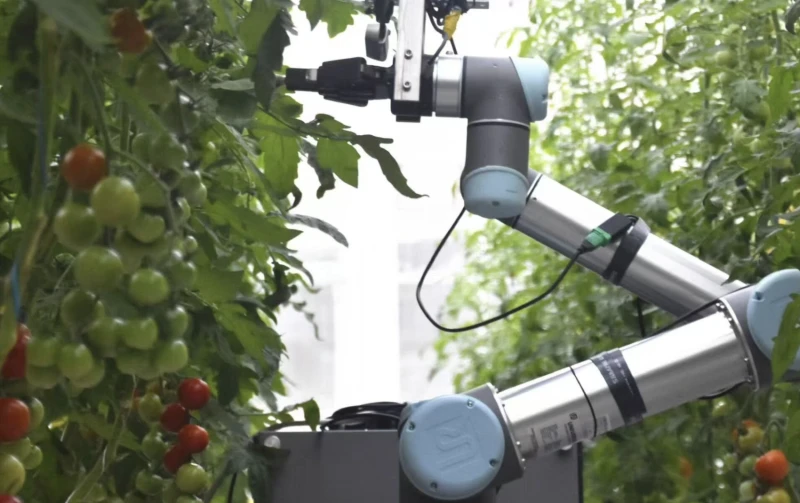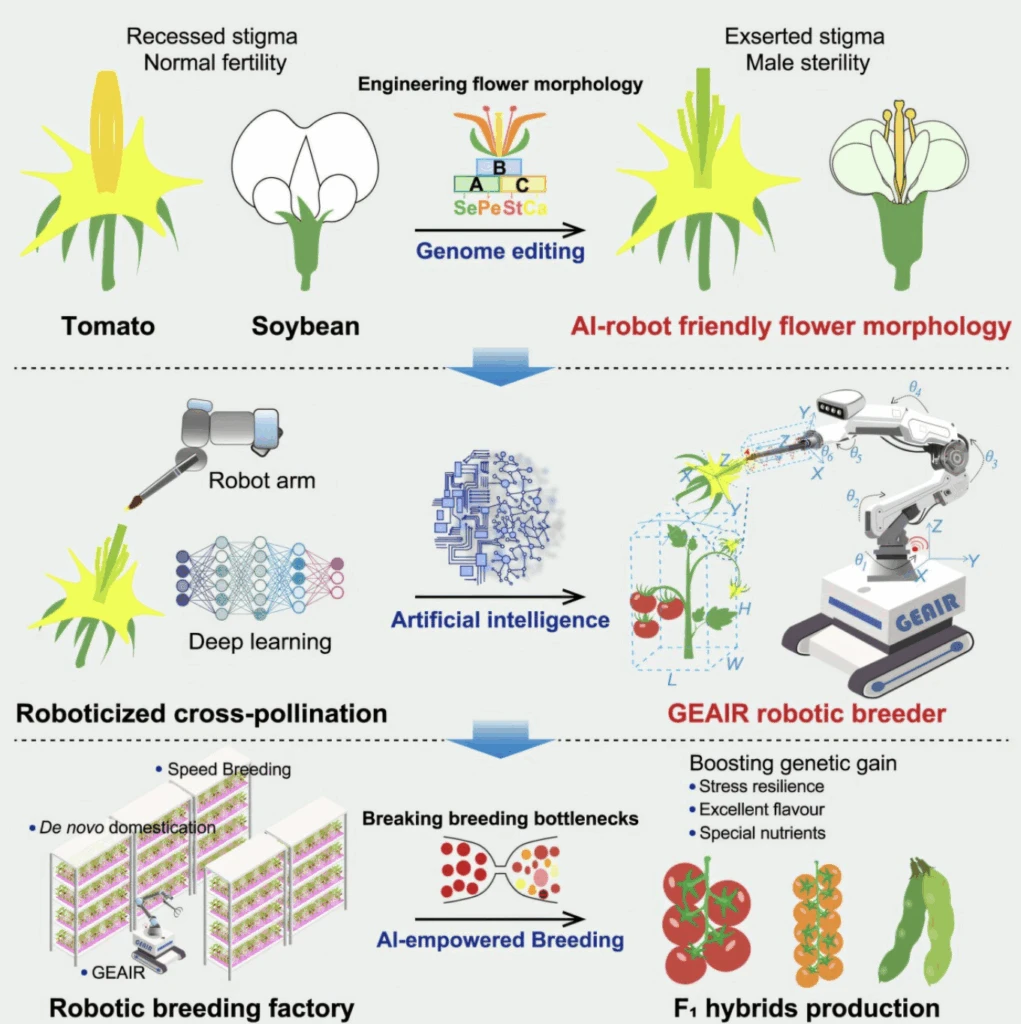Creating easy pollinating flowers: How AI and gene editing work round-the-clock to speed up crop breeding
Creating easy pollinating flowers: How AI and gene editing work round-the-clock to speed up crop breeding


For millennia, developing resilient crops relied on pollination by nature or humans—making the process long and often costly. Now, scientists from the Institute of Genetics and Developmental Biology (IGDB) of the Chinese Academy of Sciences have reimagined the pollination process by developing a new system that uses gene editing to create flowers that can be easily pollinated by AI-controlled robots working round the clock.
The system, known as Genome Editing with Artificial-Intelligence-based Robots (GEAIR), addresses a long-standing pollination hurdle: Hybrid breeding—which involves cross-pollination between different parent plants—produces higher-yielding, hardier crops. However, it relies on slow, costly manual labor to manage the pollination since recessed stigmas (female organs) and complex floral structures in key crops like tomatoes and soybeans have stymied robotic automation.
These findings were detailed in the journal Cell on August 11.
“Human hands can navigate these flowers, but at a steep price,” noted Prof. Xu Cao, the corresponding author of the study.
In China alone, manual pollination eats up more than 25% of fresh-market tomato breeding costs. In particular, emasculation—where male parts are removed to disable self-pollination—consumes 40% of that labor. Soybeans’ tightly sealed flowers block natural cross-pollination, forcing such labor-intensive manual breeding that farmers still cannot access more than 30% yield boost from hybrid vigor.
Drawing inspiration from the Green Revolution—when crops were reengineered for machinery—the team pioneered “crop–robot co-design” to create crops well-adapted to robotic technology. On the crop design side, they used CRISPR-Cas9, a precision gene-editing tool, to target B-class MADS-box genes such as GLO2 in tomatoes, which regulate flower development.

Credit: Cell (2025). DOI: 10.1016/j.cell.2025.07.028
The result is plants that are both male-sterile (eliminating the need for emasculation) and have protruding stigmas, making them easy for robots to access. “We gave flowers a makeover for machines,” Prof. Xu said.
To complement the newly designed crops, GEAIR’s custom robot is equipped with deep learning-based computer vision that identifies ready flowers and uses a precision arm to deposit pollen—matching human efficiency while working 24/7.
Its versatility expands beyond cross-pollination: It can aid self-pollination (potentially replacing bumblebees in controlled environments), collect pollen, and even select male-sterile or fertile plants by spotting exposed stigmas—obviating expensive DNA tests.
When paired with speed breeding (accelerating growth via extended light cycles) and de novo domestication (rapidly incorporating wild traits), GEAIR slashes breeding timelines. The team demonstrated this by developing new tomato lines with richer flavor and better stress tolerance—and the approach works for soybeans too, pointing to broad agricultural applications.
“GEAIR isn’t just a tool—it’s a paradigm shift,” Prof. Xu emphasized. “We’re redesigning crops to unlock AI and robotics, and those technologies are supercharging our ability to create better crops, faster.”
The study underscores a new era in agriculture: By co-engineering plants and machines, scientists are paving the way for faster, cheaper, and more sustainable crop development—a critical need as global demand for resilient food systems grows.
Crucially, the strategy proved transferable. Multiplex gene editing successfully recapitulated the male-sterile, exserted-stigma phenotype in soybean, a globally critical legume. This signals GEAIR’s potential applicability across a wide range of major crops hindered by similar floral morphology bottlenecks in hybrid breeding.
A version of this article was originally posted at Phys.org and has been reposted here with permission. Any reposting should credit the original author and provide links to both the GLP and the original article. Find Phys.org on X @physorg_com

 | Videos | More... |

Video: Nuclear energy will destroy us? Global warming is an existential threat? Chemicals are massacring bees? Donate to the Green Industrial Complex!
 | Bees & Pollinators | More... |

GLP podcast: Science journalism is a mess. Here’s how to fix it

Mosquito massacre: Can we safely tackle malaria with a CRISPR gene drive?

Are we facing an ‘Insect Apocalypse’ caused by ‘intensive, industrial’ farming and agricultural chemicals? The media say yes; Science says ‘no’
 | Infographics | More... |

Infographic: Global regulatory and health research agencies on whether glyphosate causes cancer
 | GMO FAQs | More... |

Why is there controversy over GMO foods but not GMO drugs?

How are GMOs labeled around the world?

How does genetic engineering differ from conventional breeding?
 | GLP Profiles | More... |

Alex Jones: Right-wing conspiracy theorist stokes fear of GMOs, pesticides to sell ‘health supplements’




 A single high dose of LSD can ease anxiety and depression for months
A single high dose of LSD can ease anxiety and depression for months CRISPR pork: U.S. approves first gene-edited pigs for consumption
CRISPR pork: U.S. approves first gene-edited pigs for consumption From plastic coasters to human hearts: Inside the race to print the human body
From plastic coasters to human hearts: Inside the race to print the human body Baby food panic, brought to you by trial lawyers hoping to prosecute by press release
Baby food panic, brought to you by trial lawyers hoping to prosecute by press release Viewpoint: Life and death decisions: RFK, Jr.’s shady FDA “expert panels” operate in secret with no transcripts or conflict of interest reviews
Viewpoint: Life and death decisions: RFK, Jr.’s shady FDA “expert panels” operate in secret with no transcripts or conflict of interest reviews ‘SuperAgers’: Why some people have the brains and memory capacity of people decades younger
‘SuperAgers’: Why some people have the brains and memory capacity of people decades younger  From ‘Frankenfood’ to superfood: Can the purple tomato overcome GMO myths to win over consumers?
From ‘Frankenfood’ to superfood: Can the purple tomato overcome GMO myths to win over consumers? When farmers deny science: The hypocrisy hurting agriculture’s credibility
When farmers deny science: The hypocrisy hurting agriculture’s credibility GLP podcast: ‘Fight fire with fire.’ How one science advocate converts vaccines skeptics
GLP podcast: ‘Fight fire with fire.’ How one science advocate converts vaccines skeptics
